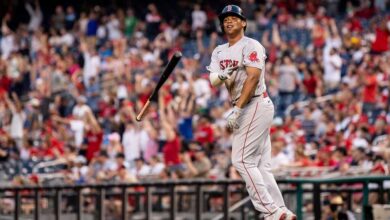

Before Jake Peavy started Game 4 of the American League Division Series, Bill Simmons had a great tweet about the Jose Iglesias trade. With Peavy helping lead the Boston Red Sox to victory over the Tampa Bay Rays, and the Detroit Tigers knocking off the Oakland Athletics, the two will meet in the ALCS. So, I’ll make an early evaluation of the trade.
First, a quick summary. Peavy and Iglesias, a shortstop, were swapped in a three-team deal involving the Red Sox, Tigers and Chicago White Sox. The Red Sox gave up Iglesias, who was hitting .330 while playing sensational defense, for the veteran Peavy. The White Sox and Tigers exchanged toolsy prospect Avisail Garcia.
Since the trade to the Tigers, Iglesias has hit less like Derek Jeter and more like Rey Ordonez. In 148 plate appearances, he posted a .259/.306/.348 line. He struck out in 20.3 percent of his plate appearances, while walking in 2.7 percent. In the ALCS, he managed just one single and one walk in 14 plate appearances, and was not in the starting lineup for Game 5. His Isolated Power of .083 was one of the weakest in the majors.
Even with a .356 BABIP, Iglesias was just a league average hitter in 2013. A look at his batted ball profile shows only two hitters with at least 350 plate appearances hit infield flies at a higher rate. He didn’t hit too many line drives, either. Infield flies aren’t conducive to a high BABIP, and while Iglesias can use his speed to leg out infield singles, his BABIP talent is probably in the .270-.290 range. Of course, he flashes a great glove, and while he does so, he can be a starter. His ceiling is probably that of Adam Everett or Brendan Ryan. Remember, Iglesias is a career .257/.307/.314 minor-league hitter.
Peavy isn’t the ace he was in 2007. However, 2012 was a strong year for Peavy, and he threw more than 200 innings for the first time since 2007. He was seventh in the AL in ERA- and ninth in FIP-. Before the trade, Peavy had excellent strikeout and walk rates of 23.5 percent, and 5.3 percent, respectively. Troubles with the longball kept his ERA at 4.28.
Since the trade, Peavy has been fairly pedestrian. The strikeout and walk rates have declined to 16.9 percent and 7.1 percent, respectively. Of course, that’s against only 266 batters, and it would be foolish to say Peavy has lost his strikeout stuff based on that sample. Still, his whiff rate and zone-contact rate in 2013 represent a downturn from recent years. It’s safe to say his strikeout ability is somewhere between the pre- and posttrade rates. Low BABIP and HR/FB rates kept his posttrade ERA at 4.04.
Peavy isn’t a groundball pitcher anymore. In fact, of the 107 pitchers who threw at least 140 innings this year, only three had a lower groundball rate than Peavy. Assuming a league average strikeout rate going forward, Peavy will surrender his share of longballs. He’s under contract with the Red Sox for 2014 at $14.5 million, with a $15 million player option for 2015. In a rotation as deep as the Red Sox’s, he’s a No.4 pitcher.
I’ll call this trade a win for the Red Sox. I liked it at the deadline, and nothing has happened since to change my mind. They sold high on Iglesias, a light-hitting shortstop, and received a solid, if injury-prone, starter in return. While Peavy has been average, Iglesias has predictably regressed offensively, even with a still-high BABIP.
Ultimately, the Red Sox got a pitcher who is comparable to Matt Garza with an extra year of control for a significantly lower price than the Texas Rangers paid for a rental. Jake Peavy is helping the Red Sox win playoff games. We’ll see if Tigers manager Jim Leyland has enough faith in Jose Iglesias’ glove to keep him in the lineup.




